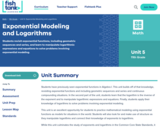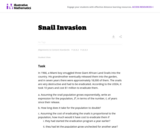
Explore how to determine the amount of compound interest earned on an investment. Assess learning with a quiz. [4:56]
- Subject:
- Mathematics
- Material Type:
- Audio/Video
- Provider:
- Sophia Learning
- Date Added:
- 12/01/2023

Explore how to determine the amount of compound interest earned on an investment. Assess learning with a quiz. [4:56]

Students act as R&D entrepreneurs, learning ways to research variables affecting the market of their proposed (hypothetical) products. They learn how to obtain numeric data using a variety of Internet tools and resources, sort and analyze the data using Excel and other software, and discover patterns and relationships that influence and guide decisions related to launching their products. First, student pairs research and collect pertinent consumer data, importing the data into spreadsheets. Then they clean, organize, chart and analyze the data to inform their product production and marketing plans. They calculate related statistics and gain proficiency in obtaining and finding relationships between variables, which is important in the work of engineers as well as for general technical literacy and decision-making. They summarize their work by suggesting product launch strategies and reporting their findings and conclusions in class presentations. A finding data tips handout, project/presentation grading rubric and alternative self-guided activity worksheet are provided. This activity is ideal for a high school statistics class.

Biology 2e is designed to cover the scope and sequence requirements of a typical two-semester biology course for science majors. The text provides comprehensive coverage of foundational research and core biology concepts through an evolutionary lens. Biology includes rich features that engage students in scientific inquiry, highlight careers in the biological sciences, and offer everyday applications. The book also includes various types of practice and homework questions that help students understand—and apply—key concepts. The 2nd edition has been revised to incorporate clearer, more current, and more dynamic explanations, while maintaining the same organization as the first edition. Art and illustrations have been substantially improved, and the textbook features additional assessments and related resources.


By the end of this section, you will be able to do the following:
Explain the characteristics of and differences between exponential and logistic growth patterns
Give examples of exponential and logistic growth in natural populations
Describe how natural selection and environmental adaptation led to the evolution of particular life history patterns

Students learn about biomedical engineering while designing, building and testing prototype surgical tools to treat cancer. Students also learn that if cancer cells are not removed quickly enough during testing, a cancerous tumor may grow exponentially and become more challenging to eliminate. Students practice iterative design as they improve their surgical tools during the activity.

Harry and his friend make a wager on a game of chess and discuss the concept of exponential growth in this short Cyberchase video. [3:26]

Students revisit exponential functions, including geometric sequences and series, and learn to manipulate logarithmic expressions and equations to solve problems involving exponential modeling.

This video lesson shows students that math can play a role in understanding how an infectious disease spreads and how it can be controlled. During this lesson, students will see and use both deterministic and probabilistic models and will learn by doing through role-playing exercises. [33:55]

The purpose of this task is to introduce students to exponential growth. While the context presents a classic example of exponential growth, it approaches it from a non-standard point of view. Instead of giving a starting value and asking for subsequent values, it gives an end value and asks about what happened in the past. The simple first question can generate a surprisingly lively discussion as students often think that the algae will grow linearly.

Explore the fast-paced nature of exponential growth. This interactive exercise focuses on introducing exponents, providing the opportunity to practice solving exponential problems, and comparing graphs of linear and exponential growth then you get to try graphing some linear and exponential equations of your own.

In this lesson, students will use the exponential function equation to solve real-life problems involving exponential growth and decay including the compound interest formula.

Through this video lesson, students compare exponential growth to polynomial growth and discover how quickly the number can grow or decay in exponentials.

The purpose of this task is to give students experience modeling a real-world example of exponential growth, in a context that provides a vivid illustration of the power of exponential growth, for example the cost of inaction for a year.

Find a quick, concise explanation of exponential growth. An example is given and clearly explained.

This site explains exponential growth and decay and how it applies to the real world with its use in bacterial populations.